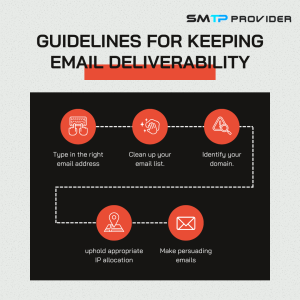
Transactional emails play a critical role in ensuring smooth communication with your customers. These emails, often triggered by user actions, include order confirmations, password resets, shipping notifications, and account updates. However, ensuring that these essential emails land in your recipients’ inboxes—and not in the spam folder—can be a challenge. This is where improving email deliverability becomes vital.
In this article, we’ll explore practical steps to enhance the deliverability of transactional emails while seamlessly integrating essential keywords like SMTP service provider and SMTP server.
What Is Email Deliverability?
Email deliverability refers to the ability of an email to successfully reach a recipient’s inbox. Even if your email is sent, it doesn’t guarantee that it will land in the primary inbox; it might end up in the spam folder or get blocked entirely.
Transactional emails must have high deliverability since they are crucial for building trust with your users. Delayed or lost emails could harm your business reputation or disrupt user experience.
Why Deliverability of Transactional Emails Matters?
- User Experience: Emails like password resets or purchase confirmations must be delivered promptly to maintain seamless customer interactions.
- Brand Reputation: Poor deliverability rates can erode customer trust and damage your brand.
- Regulatory Compliance: Failing to deliver important notifications could result in non-compliance with regulations like GDPR or CAN-SPAM.
To ensure transactional emails fulfill their purpose, you need a reliable SMTP server and must adopt email best practices.
Statistics
Transactional emails boast much higher open rates than marketing emails, averaging 47.1% compared to just 14.7% for marketing emails.
Steps to Improve Transactional Email Deliverability
1. Choose a Reliable SMTP Service Provider
The foundation of high email deliverability is a dependable SMTP service provider. These providers ensure that your emails are delivered efficiently and securely.
A good SMTP service provider offers features such as:
- Authentication protocols like SPF, DKIM, and DMARC to boost credibility.
- High delivery rates with fewer bounces.
- Advanced analytics to monitor email performance.
When selecting an SMTP service provider, look for scalability, support, and integration capabilities. This will ensure your transactional emails consistently reach your audience.
2. Use a Dedicated SMTP Server
Sharing an SMTP server with other senders can hurt your deliverability. If another sender on the shared server has poor email practices, it can lead to IP blacklisting, which affects all users. A dedicated SMTP server solves this problem by isolating your emails from others, giving you better control over your sending reputation.
3. Authenticate Your Emails
Email authentication protocols are essential for proving that your emails are legitimate and trustworthy. The key protocols are:
- SPF (Sender Policy Framework): Ensures that only authorized servers can send emails on your behalf.
- DKIM (DomainKeys Identified Mail): Adds a cryptographic signature to verify the email’s authenticity.
- DMARC (Domain-based Message Authentication, Reporting, and Conformance): Protects your domain from being used for phishing attacks and ensures alignment between SPF/DKIM.
Most SMTP service providers simplify the process of setting up these protocols.
4. Monitor IP Reputation
Your sending IP’s reputation significantly impacts email deliverability. Poor sending practices—like sending to invalid addresses or high bounce rates—can damage your IP reputation. Use SMTP server checker tools to monitor your IP score regularly and address any issues promptly.
5. Segment Your Email List
Not all users interact with your emails in the same way. Segmenting your email list allows you to tailor your transactional emails for different audiences. For instance:
- Frequent buyers may appreciate faster shipping updates.
- New users might benefit from onboarding emails.
Segmentation improves engagement, which signals to email providers that your emails are valuable.
6. Avoid Spam Triggers
Email service providers analyze your content for spammy elements. Avoid:
- Overusing all caps or excessive punctuation (e.g., “ACT NOW!!!”).
- Too many links in the email body.
- Misleading subject lines.
Focus on creating clean, professional, and relevant content.
7. Maintain a Clean Email List
Sending emails to invalid or inactive addresses reduces deliverability rates and can lead to your domain being flagged as spam. Regularly clean your email list by:
- Removing invalid email addresses.
- Pruning unengaged users.
- Using double opt-in to confirm valid recipients.
A reliable SMTP service provider can help you manage your contact lists effectively.
8. Monitor Email Engagement Metrics
Track metrics like open rates, click-through rates, and bounce rates. High engagement rates improve your sender reputation, while low engagement may indicate issues with your email content or targeting. Use analytics tools provided by your SMTP service provider to gain actionable insights.
9. Use a Recognizable Sender Name and Email Address
Emails sent from generic addresses like noreply@example.com are less likely to be trusted. Use a branded and recognizable sender name, such as support@yourcompany.com, to enhance credibility.
10. Test Before Sending
Testing your transactional emails is crucial. Use tools to check:
- Spam scores.
- Email rendering across devices and email clients.
- Authentication setup (SPF/DKIM/DMARC).
An SMTP server often includes testing features to optimize your email content before sending it live.
Benefits of Partnering with the Right SMTP Service Provider
An efficient SMTP service provider is integral to ensuring reliable transactional email delivery. They provide:
- 24/7 Support: Quick assistance for any email delivery issues.
- Scalability: Seamless handling of high email volumes.
- Detailed Reports: Insights into email performance and deliverability trends.
The right provider simplifies the process, helping your business maintain high deliverability and customer satisfaction.
Final Thoughts
Improving the deliverability of transactional emails is not just about technology—it’s about creating trust. A robust SMTP server, proper authentication, and adherence to email best practices are critical for achieving consistent inbox placement.
By partnering with a reliable SMTP service provider and adopting the strategies discussed above, your transactional emails can effectively support your business goals while enhancing customer satisfaction.
Remember: Your customers depend on these emails. Make sure they’re delivered promptly and professionally every time.
 Your Success, Our Priority: Our team is here to assist you!
Your Success, Our Priority: Our team is here to assist you!





